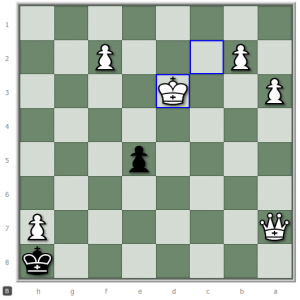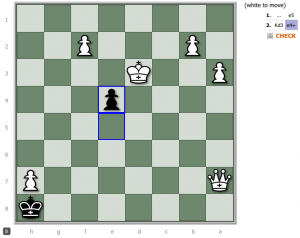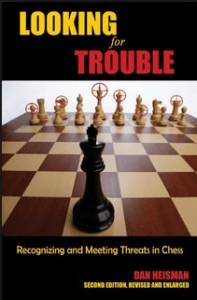Stalemate in chess happens when it is your turn to move and your King is not in check, but you cannot move except into check. Here is a photograph of the conclusion of one of my recent games. I am Black and have just managed to secure a draw by inducing stalemate.

Honestly speaking, I was a little surprised that my ruse worked. After all, stalemate in chess is relatively rare. Indeed, I had been about to resign because the situation seemed hopeless. I was left with just the King and a pawn against a promoted Queen and four pawns…

However, I noticed that, as my King was not in check and was unable to move, I might be able to draw by stalemate via my pawn because Black had moved the King towards the centre, where I had no choice but to advance the pawn and check the King…
All I had to do was NOT to resign, swiftly advance my pawn and declare check in as matter-of-fact a tone as I could muster.
Remember Pavlov’s Dog
Sure enough, my opponent took the pawn with his King, just as Pavlov’s dog salivated at the sound of a bell.

In the lower echelons of chess, in casual games, this kind of thing can be encouraged to happen. To a casual player, it may seem obvious that a checked King should take the checking piece if it can; so, if you make your move without making a fuss, the your opponent may be hypnotized into giving away stalemate.
It is a last-ditch tactic, not guaranteed to work by any means, and much less likely to work against a more experienced player, who would most probably move his King out of check without taking the pawn because he is already aware of the danger of stalemate.
Even so, whenever you find yourself heading into the endgame at a severe disadvantage, keep your eyes open for an opportunity to lure your opponent into responding with a Pavlovian move that results in stalemate.
Most times it will probably not work, but remember, stalemate in chess is always a draw, so it is always worth trying if you are on your way to losing a game!
Don’t Play Chess on Autopilot!
 On the other hand, if you find yourself entering the endgame at an advantage, beware of switching into autopilot and thoughtlessly taking any piece your opponent may place in your path… there may yet be method in his madness and you could find yourself walking into a stalemate draw.
On the other hand, if you find yourself entering the endgame at an advantage, beware of switching into autopilot and thoughtlessly taking any piece your opponent may place in your path… there may yet be method in his madness and you could find yourself walking into a stalemate draw.
To avoid this kind of oversight, and other more authentic threats, you need to train yourself to look out for trouble at every stage of the game. One of the best books that trains you to do that is Looking For Trouble: Recognizing and Meeting Threats in Chess by Dan Heisman.